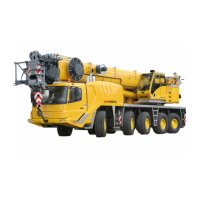3-117
RT9150E OPERATOR MANUAL OPERATING CONTROLS AND PROCEDURES
Published 2-23-2017, Control # 644-00
General
The purpose of the differential lock is to provide maximum
traction and control on poor road or highway surfaces. When
the differential locks are actuated, the clutch collar
completely locks the differential case, gearing, and axle
shafts together, thus maximizing traction to both wheels of
each axle. The lock position will also protect against spinout.
When normal driving conditions exist (during periods of good
traction), the differential locks should not be actuated. The
axles should be allowed to operate with differential action
between both wheels.
When using the differential locks, the operator must
remember the following:
1. The AXLE DIFF control switch is a momentary rocker
switch and must be held in the LOCK position.
2. The differentials can be locked or unlocked when the
vehicle is standing still or at a constant low speed when
the wheels are not slipping.
3. Lock differentials and operate vehicle only at low
speeds.
4. When the differentials are locked, the crane’s turning
radius will increase, creating an understeer condition.
The operator must use caution, good judgement and
drive at low speeds when operating the vehicle with
locked differentials.
NOTE: Turning on hard surfaces with locked differentials
should be avoided.
5. Lock the differentials only when maximum traction is
needed on poor road or highway surfaces.
6. Always unlock the differentials when the need for
maximum traction has passed or when traveling on good
road or highway surfaces.
7. Do not lock the differentials when the wheels are
slipping. Damage to the differentials can result.
8. Do not lock the differentials when the vehicle is traveling
down steep grades and traction is minimal. Potential
loss of vehicle stability can result.
Operation
The differential lock (AXLE DIFF) should preferably be
engaged when the crane is STATIONARY but may be
engaged when moving if the following conditions are met.
1. The crane is moving very slowly (creep speed).
2. The wheels are not spinning at the time of engagement.
When traveling with the lock engaged do not deviate from a
straight path more than is absolutely necessary.
1. When operating the differential lock, place switch to the
locked position with crane stationary or at slow speed.
2. If moving at slow speed, let up momentarily on the
accelerator to relieve torque on the differential gearing.
This will fully engage the differential locks. When
activated the square amber LED on the switch should be
illuminated.
3. Proceed over the poor road condition cautiously.
When adverse condition has passed, do the following:
1. Place the differential lock (AXLE DIFF) switch to the
UNLOCK position while maintaining slow speed.
2. Let up momentarily on accelerator to relieve torque on
differential gearing, allowing differential to fully unlock.
The square amber LED on the switch should go out.
3. Resume driving at a normal speed using good driving
judgement.
Proper Operation of Axle Oscillation
Lockouts
NOTE: The following procedure should be used to
periodically check the axle oscillation system and
ensure that it is in proper working condition.
1. Ensure the tires are inflated to the recommended
pressure. Refer to the Load Chart Book in the crane cab
for proper inflation pressures.
2. With the hook unloaded, the boom fully retracted and
centered over the front at no more than a 10 to 15
degree boom angle, place the crane on a block or curb
so that one rear tire is approximately 15 to 30 cm (6 to 12
inches) above the level of the opposite tire.
3. Slowly swing the superstructure to the right or left until
the axle oscillation lockout valve is activated. This will
lock the rear axle out of level. Do not swing beyond the
tire track.
4. After engaging the swing brake, slowly drive off of the
block or curb and stop. The rear tires should both be
touching the road surface and the opposite front tire
should be light or slightly off the road surface.
5. Release the swing brake and swing the superstructure
until it is centered over the front.
6. If the axle oscillation lockout valve is not functioning
properly, the crane will not re-level itself. If the rear axle
does not lock or unlock properly, evaluate the lockout
system and repair as necessary.
CAUTION
Do not operate the crane if the axle oscillation lockout
system is not functioning properly.
Reference Only

